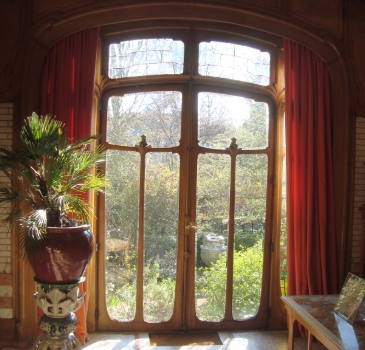This 3-hour private tour is a good option for those looking for a new way to discover art nouveau in Brussels, as it focus on the relationship between the Belgian colony The Congo and the growth of art nouveau in Belgium. You will discover several interesting art nouveau façades, some of them of the great masters Paul Hankar, Victor Horta and van de Velde. You will walk along the neighborhoods around the Parc du Cinquantenaire, spending most of the time discovering façades and the history behind them.
Your private guide will pick you up in the Etterbeek area to start the tour. While discovering several Art Nouveau buildings there, if you are interested you may have a break in a nice café. As this is a private tour you will decide that. The Cauchie House is one of the art nouveau buildings discovered during this exclusive private tour in which you will learn about the origins of Art Nouveau in Brussels and the world.
Then, you will head to Parc du Cinquantenaire and there go to visit a hidden gem, a building by Victor Horta. Although classical in appearance, the building shows the first steps of the young Horta into the new style. For the upper middle class in Brussels, working with Horta was a symbol of success and sophistication.
After enjoying a walk in the park you will walk around the Ambiorix, Marie-Louise and Marguerite Squares. Until the arrival of the art nouveau times it was a rural area but it then became a middle-class residential area. This explains why still now these small public gardens have numerous art nouveau mansions. Beyond buildings there’s a fountain, a waterfall, artificial grottos and a play area there. Our private tour may end in the area.
How The Congo and The Brussels International Exposition helped Art Nouveau:
At the end o the 19th Century Congo was a Belgian Colony, and the main source of revenues for its King Leopold II. The Imperial Belgian regime introduced Art Nouveau in Congo, but it was in Belgium’s capital Brussels where this art style had its major expression. The Congo natural resources represented a great source of currency for many Belgian burgeoise which built amazing mansions and flats to show their success to the rest of the society.
The Brussels International Exposition held in Brussels in 1897 also helped art nouveau to develop in the Belgium capital. There were 27 participating countries, and an estimated attendance of 7.8 million people. The main venue of the fair was the Cinquantenaire Park and showcased art nouveau architecture and other arts works, as well as King Leopold II of Belgium’s personal property, the Congo Free State. In the international event, Victor Horta built a small temple and succeeded in designing an almost “organic” interpretation of the classical temple, without completely abolishing any reference to an historical style.
You can find more information on the origins of art nouveau and Belgium’s colonial past in an article one of our experts wrote about the topic in our blog, CLICK HERE to read it.

